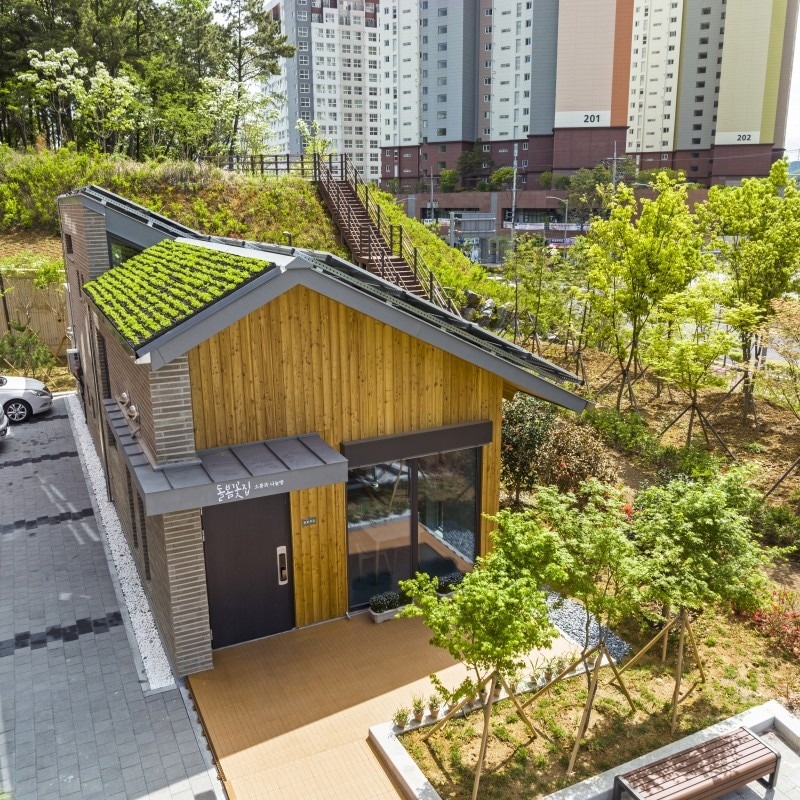The invention of the new “Net Zero Carbon Building (NZCB) system” by the Korea Institute of Civil Engineering and Building Technology is a game-changer in the field of ecological building technology. This cutting-edge solution, which is designed to reduce both operational and embodied carbon, holds the key to drastically lowering carbon emissions in the construction sector.

NZCB system test site (Gaho community center, Jinju city, Korea). Image Credit: Korea Institute of Civil Engineering and Building Technology
One of the most important aspects of addressing carbon neutrality involves embodied carbon, which includes the carbon emissions produced during the manufacturing, shipping, construction, and disposal of building materials.
The reduction of “embodied carbon” from the stage of material manufacture is crucial, in addition to the well-known “operating carbon” released throughout the building’s operational period. Operational and embedded carbon account for almost 39% of the world’s greenhouse gas emissions, according to Global ABC’s 2019 study.
In the past, the building industry has mostly concentrated on reducing carbon emissions by optimizing operational energy, such as lighting and heating. However, it is now understood that reducing embodied carbon is a crucial step in attaining carbon-neutral construction.
To meet this problem, the Ecological Building Research Group at KICT (Dr. Hyeon Soo Kim, Dr. Soo-Young, and Moon) has created a novel NZCB system that successfully reduces both operational and embodied carbon. In Jinju City, Korea, this innovative technology was recently tested.
Thirteen significant technologies were included in the NZCB system by the research team, which was headed by Dr. Hyeon Soo Kim. The use of environmentally friendly cement (High Sulfated Calcium Silicate Cement, HSCSC), which has the amazing potential to reduce CO2 emissions by more than 90% while limiting environmental damage, stands out among these technologies.
A typical concrete ingredient called Ordinary Portland Cement (OPC) produces 1.2 kg of carbon per kilogram while being produced. HSCSC, in comparison, releases just 0.07 kg of carbon per kilogram, which results in 1,130 kg fewer carbon emissions per ton than OPC.
The creation of CXP (Cellulose X-linked Polymer), an eco-friendly thermoplastic made only of wood and natural resin, is another significant accomplishment. The research team was a global pioneer in developing and using CXP-based deck materials for exterior usage.
The study team monitored operational and embodied carbon reduction at the Gaho community center in Jinju City, Korea, to assess the effectiveness of the NZCB system. An analysis was done to compare the community center’s environmental performance and embodied carbon emissions to those of a conventional Reinforced Concrete Building (RCB).
Environmental performance was evaluated across sixteen impact categories using the Product Environmental Footprint (PEF) guidance from the European Union. According to the findings, the Gaho community center was more environmentally friendly than steel and concrete structures.
Specifically, the effect of climate change—which is directly related to carbon emissions—was almost halved. A decrease of 25.7 tons of embodied carbon was discovered, with the embodied carbon effect being determined to be 56.3% lower than the comparative RCB.
A possible annual decrease of 2.2 tons of carbon emissions is also shown by the electrical energy usage data for a five-month period beginning in September 2022. Utilizing only half of the energy generated allows for this decrease.
As a result, 33.1 tons of carbon were released during the building of the Gaho community center in Jinju City. However, it is predicted that the extra power generation will offset 2.2 tons of embodied carbon emissions every year.
The Gaho community center intends to achieve net zero carbon building status within a 15-year timeframe, according to this development.
The demonstration project’s incorporation of thirteen innovative technologies will not only decrease carbon emissions and minimize environmental impacts in the construction industry but also make a significant contribution to the future growth of the ecological building market.
Dr. Hyeon Soo Kim, Korea Institute of Civil Engineering and Building Technology
A government-funded research institution with 40 years of substantial research expertise, the Korea Institute of Civil Engineering and Building Technology is at the forefront of resolving societal problems that are directly connected to the standard of living of the populace.
The Ministry of Land, Infrastructure, and Transport funded the research through project number RS-2018-KA146511, Development of performance criteria of ecological architecture based on Environmental Product Declaration and modularization construction technology (2018–2022).
The most recent edition of CO2 emissions of concrete and timber slabs, a prominent worldwide publication in the concrete sector, had an article outlining the findings of this study (IF:7.2).
Journal Reference
O, J.-W., et al. (2023) Comparative CO2 emissions of concrete and timber slabs with equivalent structural performance. Energy and Buildings. doi:10.1016/j.enbuild.2022.112768.
Source: https://www.nst.re.kr/eng/index.do